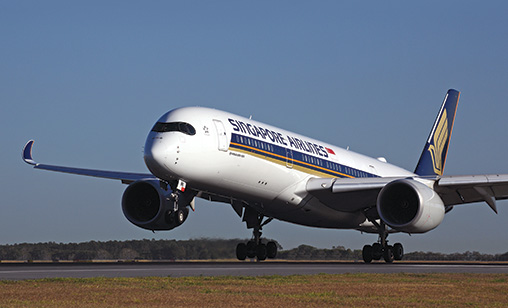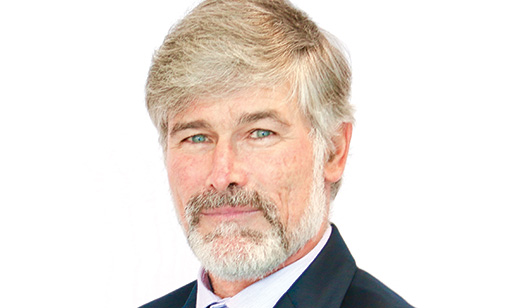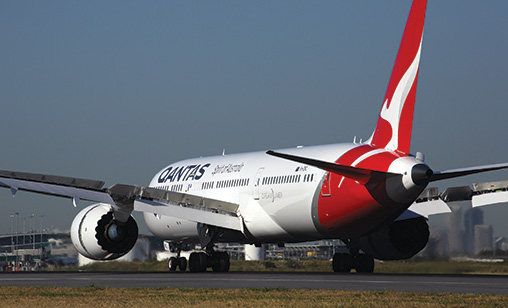Main Story
Conquering the tyranny of weariness
As more airlines embark on ultra-long haul flights they must focus on the wellness of passengers who are spending almost a day in the air. But what about the pilots? How are they being prepared for the unprecedented demands of crewing journeys of 20 hours or more? Associate editor and chief correspondent, Tom Ballantyne, reports.
June 1st 2019
Qantas Airways is counting down to Project Sunrise: non-stop journeys between Sydney and London that will take a record-breaking 21 hours. Read More » As the date draws nearer to this possible historic development, debate is focused on the rules for the cockpit crew manning these flights and the probable effects fatigue could pose to safe flying of ultra-long non-stop journeys.
As more ultra-long-haul (ULH) services take to the sky, the issue of fatigue is worrying pilots. As well, airlines are struggling to reconcile different rules in different countries and balance the economics of a flight with a safety regime that protects pilots from unintended consequences.
 |
Today’s longest flight is operated by Singapore Airlines (SIA), some 18 hours and 30 minutes between Singapore and New York’s Newark airport. The Qantas 787-9 service from Perth to London, at 17 hours and 25 minutes, is the third longest, after Qatar Airways at 17 hours and 50 minutes from Doha to Auckland.
Plans by to fly non-stop between Sydney and London will eclipse them all. The route also will raise questions about the rules that should apply for pilot duty time and rest and recovery periods.
The Flight Safety Foundation said: “Flight crew fatigue can negatively affect performance and pose a hazard to flight safety. Fatigue also has a negative impact on learning, morale and health. Regulators increasingly require operators to do more than comply with flight and duty time limitations to manage crew fatigue.
“Such requirements include demonstration of effective fatigue risk management (FRM) within a safety management system (SMS) or with a dedicated fatigue risk management system (FRMS).”
One of the essential challenges for ULH operations is selecting the best composition for the journey. SIA has four pilots on its A350 Singapore-New York service. There are two crews, a command set and a deputy set, on each flight, with each made up of a captain and a first officer, the airline explained.
Qantas’s Perth to London route also has four pilots: a captain, backed by a first officer and two second officers. The second officers only can fly at cruising altitudes and cannot take off or land. Cathay Pacific Airways, operating the A350 from Hong Kong to New York, crews the flight with two captains and two first officers.
Last year, in the United Arab Emirates (UAE), there was unrest among cockpit crew when Emirates Airline began reducing the number of pilots from four to three on ULH flights from Dubai to Boston, New York, Sydney, Melbourne, Rio de Janeiro and Sao Paulo.
It should be pointed out the decision did not contravene UAE regulations. It did, however, highlight the fact there are no standard global rules for pilot duty times. In the U.S., flights between eight and 12 hours require three pilots and flights of more than 12 hours must have four pilots crewing the aircraft. The regulations allow pilots to be rested and alert during their ULH flights. Some other countries allow “controlled rest”, which means that when two people are in the cockpit, one of them is allowed to doze off.
The problem is that as flight times break the 20-hour barrier, it is unknown territory. At present, maximum duty time for Qantas pilots is 20 hours, including time on the ground before and after the flight. Flying non-stop to London from Sydney is expected to take about 23 hours.
“We don’t have the ability to do that length of duty today, so you need to negotiate that and get the regulator comfortable with it,” Qantas Group CEO, Alan Joyce, said in interviews about the Sunrise project. For the airline, there has to be a business case and more pilots - or more senior pilots - cost more money. On the other hand, it has been estimated ULH non-stop flights can bring the airline a premium of around 20% in terms of fares charged to passengers, particularly corporate travelers, Qantas said.
 |
For Qantas and other airlines entering the ULH market, keeping customers happy on long flights involves keeping pilots happy. Cockpit crews need sufficient rest periods in suitable sleeping facilities inflight and sufficient breaks on the ground before and after flights.
Australian and International Pilots Association (AIPA) safety and technical director, Shane Loney, said the airline has been questioned about the fact it operates its ULH flights with only one caption. Loney said “unlike many airlines, at Qantas a first officer is a command endorsement, so they have the same licence qualifications as a captain. At many airlines the first officer does not have the same qualifications as a captain. It is why, in our operation, it is quite acceptable to operate with one captain and one first officer”.
It may be appropriate for a 15-hour flight, he continued, but was it appropriate “when it was it appropriate when its 20 hours long? The operator should be required to demonstrate how we are going to do that safely. They should be able to demonstrate crew rest facilities. Is there is a good chance of the pilots getting adequate rest? If you don’t get a decent sleep, you are going to be awfully tired by the end of that flight. We all know that increased fatigue leads to increased errors and increased risk,” he said.
Loney said being awake for periods over 18 hours is equivalent to a blood alcohol level at .05. “I’m pretty sure our customers wouldn’t want pilots flying around with a blood alcohol level of .05. So, we obviously need to make sure they are not going to be overly fatigued,” he said. Pilots are currently negotiating with Qantas to determine the rules for ULH flying.
The issue of ULH flying and fatigue has become a major topic of discussion with pilot groups, airlines and regulators and for good reason. In January, the Australian Transport Safety Bureau (ATSB) released a study on pilot fatigue that found 60% of long-haul pilots had experienced moderate to severe fatigue on their most recent flights.
“Fatigue is an inevitable risk in aviation,” the report said. “As it cannot be completely eliminated, it must be managed”. It added data on fatigue and its impact on air transport safety is generally only obtained if there has been an accident or incident. As a result, there is generally a lack of understanding of the baseline level of fatigue in day-to-day Australian air transport at airlines,” Loney said.
Almost 80% of long-haul pilots who responded to the ATSB study reported that their last layover had less than 40 hours of non-duty time. “Research has found long-haul flight crew who had a layover of less than 40 hours self-reported a higher level of fatigue and recorded slower reaction times in a vigilance task than flight crew who had a longer layover of an average of 62 hours. This indicates the shorter layover did not provide sufficient opportunity for recovery from the outbound flight,” ATSB said.
That situation is evident elsewhere. SIA said there are no stipulated permitted duty hours for ULH flights but two rest periods are planned to provide crew with better rest in-flight. Before operating an ULH flight, crew is required to have 48 hours of rest. During the flight, the two sets of crew work in shifts, taking turns to rest, with a minimum of two blocks of rest for each set of crew.
Each block of rest is from three to five hours. ULH flight crews are given three nights of rest before they operate the return sector. The airline said crew rosters are monitored with a fatigue measurement tool.
 |
Qantas almost certainly will be the first airline to break the 20-hour flight barrier with Project Sunrise. It believed it would make a decision on aircraft before year-end and launch Sydney to London and New York non-stop in 2023.
The AIPA is negotiating a new union contract with Qantas for long-haul pilots and CEO Joyce has said he hoped for an agreement by December. While the AIPA is supportive of the commercial benefits that could flow to the airline for operating these long premium routes with minimal competition, it wants to make sure safety and fatigue management issues are adequately addressed.
The airline’s pilots said the unprecedented length of the new flights meant the airline needed to do more research, consider more training, use more experienced pilots and change a fatigue-reporting system they considered to be flawed.
This has changed, said Loney. “Qantas has not always been good at its approach to it. We started the Dallas operation and the Perth-London operation without sufficient consultation between the pilots and the company and all the analysis that perhaps should have gone on,” he said.
“Indications are we are taking a much more serious approach to Project Sunrise, as you should expect given the length of these flights.” The AIPA and Qantas are conducting a study on the fatigue issue on the Perth-London route.
Australian pilots have not been as satisfied with the approach of the country’s Civil Aviation Safety Authority (CASA) to ULH flying “At the end of the day, the regulator sets the rules and then everybody has to follow those rules.
“If CASA does not take its job as a regulator seriously, if it does not make sure we have good regulations in place and does not enforce them, then we should not be that surprised if an airline tries to get things done the cheapest way,” said Loney.
“The regulator has a lot to answer for in ensuring we have good fatigue outcomes. At this point, we have been a little disappointed with CASA’s approach, particularly when it comes to ULH flying. We have made that displeasure very clear to CASA in multiple conversations.
“In Australia, CASA chooses not to have the pilot association as a key player in these regulatory systems and particularly on the subject of fatigue. We think that’s a big mistake.
“Qantas has a fatigue risk management system (FRMS) in place. Its a pretty good airline. They take most of these issues seriously. We have some good fatigue monitoring systems in place. We think it is very, very important that pilots are always part of this [discussion].”
The Flight Safety Foundation agreed the extent an operator effectively manages fatigue, like any risk, depends on the effectiveness of the system of controls that are in place. The necessary controls usually include:
• Fatigue management training for crew, schedulers and managers
• A crew fatigue reporting system
• Fatigue risk-based scheduling rules
• A fatigue safety action group (FSAG) that coordinates the identification, assessment and mitigation of fatigue risks and continuously monitors and evaluates the effectiveness of the fatigue risk management controls and FRMS
“Despite the best efforts of operators and flight crew, there will always be situations in which flight crew experience unanticipated elevated fatigue in-flight. Alertness levels can vary considerably during the course of a flight, particularly a long flight. In addition, research that evaluates augmented long-haul flights has shown crews are not always able to sleep during scheduled rest periods in onboard rest facilities,” the foundation said.
“In addition, unexpected events such as delays and high workload due to weather can increase the risk of an error due to fatigue.”
When it comes to crew fatigue, it is agreed the issue can only be solved by the combined efforts of the International Civil Aviation Organization (ICAO) representing the regulators, the International Air Transport Association (IATA) speaking for the airlines and the pilot associations.
“From a management perspective, every business manager or owner is interested in keeping costs down. We understand that,” said Loney.
“It will be a very interesting discussion [at Qantas]. Management will want to operate the service with the lowest pilot costs they can. We will be interested to make sure we have properly qualified people reasonably rested when we get to our destinations. Time will tell quite how these conversations go.”